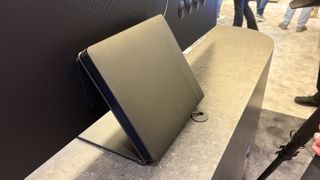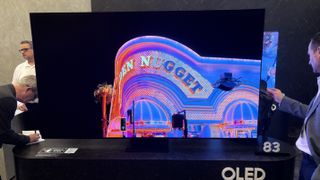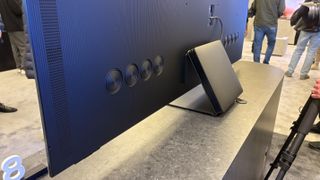The battle for OLED TV supremacy is heating up for 2025, with both LG and Samsung unveiling their latest flagship models at CES 2025. The first contender, the LG G5, brings a new four stack WOLED panel to the table, while Samsung's S95F is rocking improved QD-OLED tech.
With both manufacturers claiming significant advances in brightness and picture performance, this clash of premium OLED TVs looks set to be one of the biggest yet. Let's dive into how these two top TV powerhouses compare.
LG G5 vs Samsung S95F: sizes, estimated prices and release dates

Neither manufacturer has revealed official pricing yet, but we can make educated guesses based on their 2024 models (all taken with a generous heaping of salt, natch). The Samsung S95D launched at $2599 / £2499 / AU$3995 for the 55-inch model, $3399 / £3399 / AU$4995 for the 65in variant, and $4599 / £4599 / AU$7995 for the 77-inch version. The LG G4 entered the market at $2599 / £2399 / AU$4199 for the 55-inch model, $3399 / £3299 / AU$5299 for the 65-inch, $4599 / £4499 / AU$7999 for the 77-inch, and $6499 / £6999 / AU$9999 for the 83-inch variant.
As for the size range, LG offers a broader choice, with the G5 available in 48-inch, 55-inch, 65-inch, 77-inch, 83-inch and 97-inch variants. However, it's worth noting that the 48-inch and 97-inch models won't feature the new four stack panel technology. Samsung's S95F is expected to come in 55-inch, 65-inch and 77-inch sizes, matching last year's S95D lineup.
As for release dates? There’s nothing concrete yet, but again, we can make an educated guess. The LG G4 launched in March last year, as did the S95D, so we expect to see a similar release window this time round too.
LG G5 vs Samsung S95F: design and build

On the design front, the LG G5 has a similar aesthetic to its predecessor. Notably, LG will no longer include a stand in the box – it must be purchased separately if you don't plan on wall-mounting the TV. How strongly you feel about this omission will entirely depend on how you plan to set up your TV.
As for the S95F, it shares the slim profile of the S95D, achieved through its separate One Connect box that houses all connections and processing power. This connects to the display via a single cable, making it particularly attractive for wall-mounting scenarios. And if you’d rather not commit to wall mounting, there’s a centrally mounted pedestal stand instead. Hooray for choice.
LG G5 vs Samsung S95F: screen and picture quality

This is where things get rather interesting. LG has moved away from the MLA (Micro Lens Array) technology used in the G4, instead opting for a four stack WOLED panel. LG claims this enables the G5 to achieve around 1800 nits peak brightness in Filmmaker Mode when measured on a 10 per cent window, which is around 300 nits more than the G4. It also claims a 40 per cent increase in full-screen brightness compared to the G4, which, on paper, is nothing to be sniffed at.
As for Samsung, it’s upgraded its QD-OLED technology for the S95F, with the new panel reportedly now 30 per cent brighter than its predecessor, while maintaining the same energy efficiency. Samsung claims peak brightness figures of around 2000 nits, and the S95F retains Samsung's glare-free technology, which aims to reduce reflections. Both sets of improvements certainly sound good in practice, and we’re looking forward to putting both sets through their paces in our upcoming in-depth reviews.
LG G5 vs Samsung S95F: features and processing

Gamers will be pleased to hear that both TVs support 165Hz refresh rates, though the G5's 48-inch and 97-inch models are limited to lower refresh rates. The S95F features Samsung's new NQ4 AI Gen 3 processor, which brings the AI Upscaling Pro feature to its 4K flagship for the first time. Samsung's Vision AI features will also allow users to generate AI art for wallpapers, find actor information and discover related content all via a dedicated button on the remote.
As for LG, it’s equipped the G5 with its Alpha 11 Gen 2 processor, with enhanced AI Picture Pro capabilities that include AI Super Upscaling, Dynamic Tone Mapping Pro and Object Enhancing by Visual Perception. The G5 also introduces new personalisation features including voice recognition for user profiles, with the ability to automatically load individual picture and sound settings based on who is watching. All of the above features certainly sound intriguing, but we’ll have to wait for our final review to separate the genuinely useful from any potential tech bloat.
On the connectivity front, both TVs feature four HDMI 2.1 ports supporting up to 4K/165Hz gaming, VRR, and ALLM. Samsung supports HDR10+ but not Dolby Vision, while LG offers Dolby Vision alongside HDR10 and HLG support.
LG G5 vs Samsung S95F: sound

LG has brought its Virtual 11.1.2-channel to the G5, adding a Voice Remastering feature that claims to boost dialogue clarity without compromising other sound elements. Samsung, meanwhile, introduces its new Eclipsa Audio technology, developed in partnership with Google. According to Samsung, “Eclipsa Audio allows creators to adjust audio data such as the location and intensity of sounds, along with spatial reflections, to create an immersive three-dimensional sound experience.” How widespread this will end up becoming remains to be seen, but it’s an interesting concept nonetheless.
Built-in sound is something that even high-end TVs struggle with (hence our recommendation of choosing one of the best soundbars), but hopefully we’ll be pleasantly surprised with the audio performance in our final reviews.
LG G5 vs Samsung S95F: early verdict
While we'll need to put both TVs through their paces in our testing labs before making any definitive judgments, both the LG G5 and Samsung S95F appear to be pushing OLED technology forward in meaningful ways.
As things stand, the different approaches to panel technology – Samsung's QD-OLED versus LG's new four stack WOLED – makes this an interesting battle for OLED supremacy in 2025. Early indicators suggest both technologies have their merits, and the final verdict may well come down to specific viewing environments and user preferences.
MORE:
Read our LG C5 hands-on review
Also check out our Samsung S95F hands-on review

